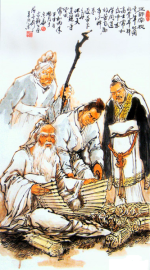Tao Teh Ching & Lao Tsu
Tao Teh Ching, or Dao De Ching (道德经), is the foremost text of Taoism, thought to be written by Lao Tsu between 6th and 4th century BC in ancient China. It is also known as Lao Tzu. Although the authorship and date of the work are subjects of academic debates, since we are concerned more with its uses, I will not delve into them here.
Tao Teh Ching consists of 81 chapters, written in verses. They are divided into two parts. Part one comprises chapters 1-37, and part two 38-81. The first is based on Tao, or “The Way”. The second is based on Te, or “The Virtue”. The order can be reversed in some versions. The third word of the title, Ching simply means “classic” in Chinese.

Timeless & Universal
Tao and Te are the two sides of dualism. Just like soul and body of a person, or principle and practice of an action. If you are familiar with the concept of yin and yang, Tao can be interpreted as yang, and Te as yin.
To me, Tao Te Ching is more a work of philosophy, rather than religion. It, however, has played a significant role in religion. In China, the school that views Dao De Ching from the philosophical perspective belongs to Daojia (道家); and the other that sees it as a religion belongs to Daojiao (道教); although both are known as Taoism in the West. Tao Teh Ching’s influence on the Chinese religion does not stop at Taoism. As it pre-existed Buddhism in China, when Buddhism was first introduced into the country, its interpretation was aided through the use of Taoist lingo.
Tao Te Ching has transcended historical and cultural confines. It is timeless and universal! In China, it has been widely read by people over the centuries, from the ordinary folks, scholars to politicians; and exerted tremendous influence on the ways of life there; including the arts, from writing, painting and calligraphy to landscaping. Since its introduction in the late 19th century, the work has been widely read in the West as well.
Dao De Ching, however, is not easy to understand. Not only is the language cryptic, it can be read all at once as a work on cosmology, self development, leadership and government, and many more. If you find it confusing, you are not alone.
To truly enjoy the work, go beyond the surface. Try to understand the underlying unified principles that hold the whole work together. Relate the principles to your chosen interest, be it self development, leadership or anything else.
For my suggestions on how to read Tao Teh Ching for personal effectiveness, please click here.
Being and Non-being
To help you with you read the book, I’ll like to touch on some of the important concepts introduced by Lao Tzu.
From the cosmological perspective, Tao Te Ching describes the beginning of Tao as “chaos”. It is an undifferentiated oneness. This may be seen as the qi-energy which produces the yin and yang energies. The concepts of yin and yang are described by Lao Tsu in Tao Teh Ching as ‘being’ or ‘you 有’; and ‘non-being’, or ‘wu 无’. As non-being, Tao is limitless and inexhaustible. The book begins by introducing Tao as beyond description, “the Tao that can be mentioned is not eternal Tao”. Non-being is the creative power of the universe. “All things under heaven are born of being (you); being is born of non-being (wu)”.
If Tao is non-being, then Te -- the virtue -- can be interpreted as being. In all things you do, it is not what you do – the being – that is of the utmost importance. It is the guiding principle and the significance of what you do – the non-being -- which you should concern about. When the virtue, or Te, is Tao based, it goes beyond the ethical confines to include also potent, efficacy, potency, efficacy, integrity and power; and is reflected in a person’s physical, intellectual, moral, and spiritual capacity. It is different from the Confucian definition of virtue, which is clearly in terms of moral character and self-discipline.
Order of Universe
Another way is to see Tao as order of the universe, and use it to guide the things you do.
Being is the things that happen around us, including what we see and what we do. It must be guided by the non-being, or order of the universe. For example, the growth of tree needs time. This is in natural order of things. If you, in order to see it grow faster, and so water it more than necessary, not only will you not get what you want, you may ruin the plant and become counter productive. The same principles apply to all things we do.
By understanding the order of universe, often you may have to do nothing in order to do something. This sounds paradoxical, but the practice can be of tremendous value to your personal effectiveness. It leads to a way of life that is simple, calm and care-free, yet fruitful. Lao Zi describes this as “non-action”, or wu wei, which literally means doing nothing.
Non-being is a very powerful concept in leadership. The soft, yielding but potent leadership that lead without the followers sensing that they are being led, has made leaders of exceptional prowess.
Read a translation of tao teh ching
Go to home page
